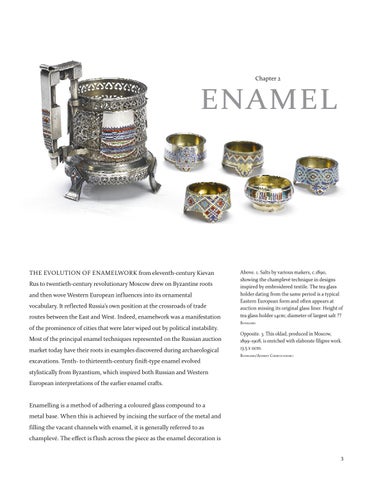CH 2. ENAMEL _Layout 1 17/12/2012 10:38 Page 2
Chapter 2
ENAMEL
THE EVOLUTION OF ENAMELWORK from eleventh-century Kievan Rus to twentieth-century revolutionary Moscow drew on Byzantine roots and then wove Western European influences into its ornamental vocabulary. It reflected Russia’s own position at the crossroads of trade routes between the East and West. Indeed, enamelwork was a manifestation
Above. 1. Salts by various makers, c.1890, showing the champlevé technique in designs inspired by embroidered textile. The tea glass holder dating from the same period is a typical Eastern European form and often appears at auction missing its original glass liner. Height of tea glass holder 14cm; diameter of largest salt ?? BONHAMS
of the prominence of cities that were later wiped out by political instability. Most of the principal enamel techniques represented on the Russian auction market today have their roots in examples discovered during archaeological
Opposite. 3. This oklad, produced in Moscow, 1899–1908, is enriched with elaborate filigree work. 13.5 x 11cm. BONHAMS/ANDREY CHERVICHENKO
excavations. Tenth- to thirteenth-century finift-type enamel evolved stylistically from Byzantium, which inspired both Russian and Western European interpretations of the earlier enamel crafts.
Enamelling is a method of adhering a coloured glass compound to a metal base. When this is achieved by incising the surface of the metal and filling the vacant channels with enamel, it is generally referred to as champlevé. The effect is flush across the piece as the enamel decoration is 3
